Transformational Gardening
July 2011 Foraging Experiences
(Back to:
June 2011 Foraging Experiences)
(Forward to:
August 2011 Foraging Experiences)
July 15, 2011
A very busy work schedule has fouled up my foraging schedule for the last month.
I have been out maybe 10 times in the last 30 days taking pictures, but very
little harvesting of plants. I did pick some Sweet Fern (Comptonia peregrina)
on Tuesday of this week. And this weekend, I plan to get an early start on harvesting
Staghorn Sumac (Rhus typhina). I could see ripe Staghorn Sumac fruit from
the highway even though it's only mid-July. The Smooth Sumac (Rhus Glabra)
isn’t even close to being ripe (still green).
The nice thing about foraging experience is that I can identify almost every weed in
my garden. The most common two weeds by far are Wild Radish (Raphanus raphanistrum)
and Annual Ragweed (Ambrosia artemisiifolia) followed by
Hairy Galinsoga (Galinsoga quadriradiata), Lambsquarters (Chenopodium album),
Cow Vetch (Vicia cracca), Common Dandelion (Taraxacum officinale),
Spotted Ladysthumb (Polygonum persicaria), Hedge False Bindweed
(Calystegia sepium), Queen Anne’s Lace (Daucus carota),
Common Milkweed (Asclepias syriaca), Yarrow (Achillea millefolium) and
Yellow Wood Sorrel (Oxalis stricta). Surprisingly, I found a couple of
Norweigian Cinqufoil (Potentilla norvegica) plants growing as weeds in the
garden. There is also a type of grass in the garden, but I cannot identify that yet.
July 16, 2011
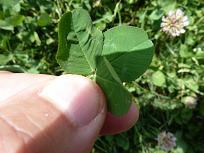
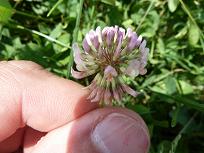 White clover flowers can vary from white to pink. Alsike Clover (Trifolium
hybridum) flowers can turn pink with age. White Clover leaflets are somewhat
round, while Alsike Clover leaflets are more of an elogated oval shape.
White clover flowers can vary from white to pink. Alsike Clover (Trifolium
hybridum) flowers can turn pink with age. White Clover leaflets are somewhat
round, while Alsike Clover leaflets are more of an elogated oval shape.
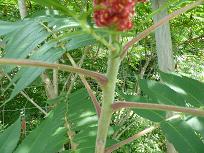
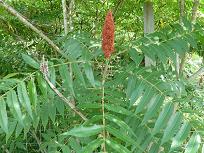 Staghorn Sumac harvesting begins. The fruit is almost ripe and it is only July 17th.
I harvested some of the ripest ones I can find for drying. Once dry, the fruit will
be ground into powder to use as a spice. Have to remember to go back in a few weeks
to harvest the rest for spice and Sumac-aide.
Staghorn Sumac harvesting begins. The fruit is almost ripe and it is only July 17th.
I harvested some of the ripest ones I can find for drying. Once dry, the fruit will
be ground into powder to use as a spice. Have to remember to go back in a few weeks
to harvest the rest for spice and Sumac-aide.
July 22, 2011
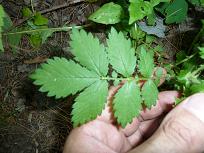
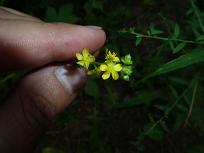 Matthew Wood has a whole chapter on the healing properties and magical properties
of agrimony in The Book of Herbal Wisdom. I never thought I would find it
within a few miles of my home! I will be getting out there to harvest for tea and
tincture. It was in the damp woods, not far from a creek. There was quite a bit
of Broadleaf Enchanter’s Nightshade (Circaea lutetiana) growing nearby.
Matthew Wood has a whole chapter on the healing properties and magical properties
of agrimony in The Book of Herbal Wisdom. I never thought I would find it
within a few miles of my home! I will be getting out there to harvest for tea and
tincture. It was in the damp woods, not far from a creek. There was quite a bit
of Broadleaf Enchanter’s Nightshade (Circaea lutetiana) growing nearby.
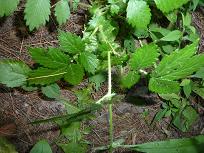
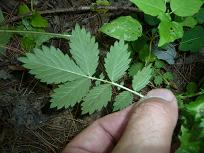 At first I thought it was a Cinquefoil. Perhaps Tall Cinquefoil (Potentilla
arguta), but Tall Cinquefoil has white flowers. Or Pennsylvania Cinquefoil
(Potentilla pectinata), but the flowers of Pennsylvania Cinquefoil grow in
a cyme rather than on a spike and the leaflets of Pennsylvania Cinquefoil are much
more deeply dissected. Then I thought it might be Pacific Silverweed (Argentina
egedii), but each flower of Pacific Silverweed grows on a separate stalk.
Flipping through all of the yellow flower pictures in a field guide was what saved
the day.
At first I thought it was a Cinquefoil. Perhaps Tall Cinquefoil (Potentilla
arguta), but Tall Cinquefoil has white flowers. Or Pennsylvania Cinquefoil
(Potentilla pectinata), but the flowers of Pennsylvania Cinquefoil grow in
a cyme rather than on a spike and the leaflets of Pennsylvania Cinquefoil are much
more deeply dissected. Then I thought it might be Pacific Silverweed (Argentina
egedii), but each flower of Pacific Silverweed grows on a separate stalk.
Flipping through all of the yellow flower pictures in a field guide was what saved
the day.
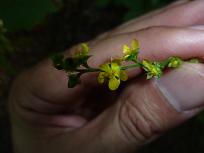
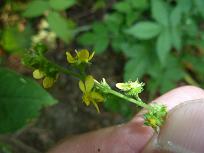 The leaves are alternate and pinnately-divided with 5-9 large, coarsely-toothed
leaflets with tiny leaflets between. The flowers are deep yellow with five petals
and look like cinquefoil flowers except that the flower petals are not notched at
the tip as with some cinquefoils. The flowers grow on spikes and are not densely
packed as they are with Roadside Agrimony (Agrimonia striata).
The leaves are alternate and pinnately-divided with 5-9 large, coarsely-toothed
leaflets with tiny leaflets between. The flowers are deep yellow with five petals
and look like cinquefoil flowers except that the flower petals are not notched at
the tip as with some cinquefoils. The flowers grow on spikes and are not densely
packed as they are with Roadside Agrimony (Agrimonia striata).
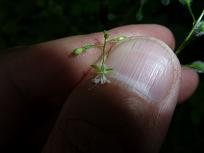
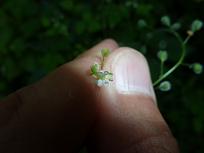 The flower has two petals that are split to make it look like four petals. Leaves are
opposite and gently, wavy-toothed. Broadleaf Enchanter’s Nightshade differs
from Small Enchanter’s Nightshade (Circaea alpina):
The flower has two petals that are split to make it look like four petals. Leaves are
opposite and gently, wavy-toothed. Broadleaf Enchanter’s Nightshade differs
from Small Enchanter’s Nightshade (Circaea alpina):
- Broadleaf Enchanter’s Nightshade flower petals are notched to less than half
of the length while Small Enchanter’s Nightshade flower petals are notched to
half of the length.
- Small Enchanter’s Nightshade flowers tend to bunch towards the top of the
cluster (usually 15 of fewer flowers) while Broadleaf Enchanter’s Nightshade
flowers are evenly spaced on the stalk.
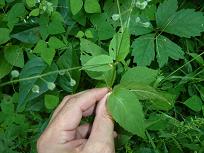
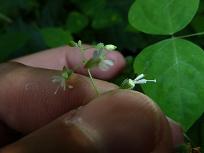
- Leaves of Broadleaf Enchanter’s Nightshade: 2-1/2 to 6 inches long,
shallowly-toothed and narrowly-pointed as
compared to Small Enchanter’s Nightshade: 3/4 to 2-1/2 inches long, sharply-toothed,
and broadly-pointed.
- Broadleaf Enchanter’s Nightshade grows to 28 inches tall while Small
Enchanter’s Nightshade grows to 12 inches tall.
- Broadleaf Enchanter’s Nightshade flowers are at least 1/4 inch wide while
Small Enchanter’s Nightshade flowers are less than 3/16 inch wide.
- Broadleaf Enchanter’s Nightshade leaves are usually not more than half as
wide as long while Small Enchanter’s Nightshade leaves are more than half as
wise as long.
- Broadleaf Enchanter’s Nightshade fruit capsules have two chambers and sticky
hairs while Small Enchanter’s Nightshade fruit capsules have one chamber and
one seed.
July 26, 2011
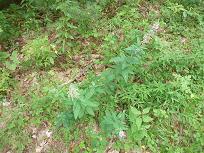
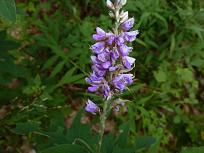 Showy Ticktrefoil is a large plant -- 2 to 6 feet tall with alternate leaves. Each
leaf has three large leaflets and sheath at the base of the petiole where it attaches
to the stem. The end leaflet has a longer petiole (leaflet stem). The leaflets are
entire (untoothed), 2 to 8 inches long, less than half as wide as long, ovate to
lanceolate and short-pointed at the tip. However, some of the lower leaves have more
oval leaflets as can be seen in one of the pictures below. The stem is very hairy,
feels 4-sided and is streaked vertically with red lines.
Showy Ticktrefoil is a large plant -- 2 to 6 feet tall with alternate leaves. Each
leaf has three large leaflets and sheath at the base of the petiole where it attaches
to the stem. The end leaflet has a longer petiole (leaflet stem). The leaflets are
entire (untoothed), 2 to 8 inches long, less than half as wide as long, ovate to
lanceolate and short-pointed at the tip. However, some of the lower leaves have more
oval leaflets as can be seen in one of the pictures below. The stem is very hairy,
feels 4-sided and is streaked vertically with red lines.
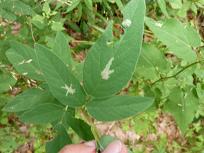
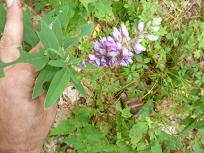 The flowers are purple, pea flowers that grow on a raceme -- an unbranched inflorescence
bearing flowers with short stalks. Older flowers appear towards the bottom of the
inflorescence and new flowers are produced as the shoot grows. For Showy Ticktrefoil,
the flowers can be bunched closely as seen in the images to the right and below or they
can be spread out slightly more than shown in the pictures.
The flowers are purple, pea flowers that grow on a raceme -- an unbranched inflorescence
bearing flowers with short stalks. Older flowers appear towards the bottom of the
inflorescence and new flowers are produced as the shoot grows. For Showy Ticktrefoil,
the flowers can be bunched closely as seen in the images to the right and below or they
can be spread out slightly more than shown in the pictures.
It can be differentiated from other plants in the genus by the hairy stem, large
lanceolate leaves (less than half wide as long), and large and often densely-packed
racemes of flowers. Panicledleaf Ticktrefoil (Desmodium panciulatum) has
similar-looking leaves and leaflets, but the stem is not as hairy (sometimes no hairs),
the leaflets are only 1 to 2 inches long, the stem does not have the vertical red lines
and the flowers do not appear to be as densely-packed.
At first I thought this was Alfalfa (Medicago sativa), but alfalfa leaflets
have teeth towards the tip. In addition, alfalfa only grows to 1 to 2 feet tall.
July 28, 2011
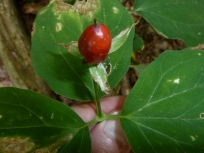
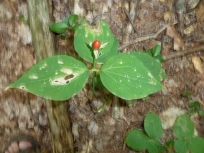 Painted Trillium is the only Trillium species in New England that has leaf stems.
All of the others have sessile leaves (without leaf stems).
Painted Trillium is the only Trillium species in New England that has leaf stems.
All of the others have sessile leaves (without leaf stems).
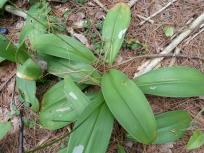
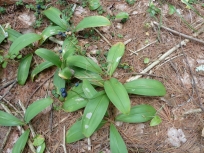 Not pictured are the yellow flowers that bloom in May and June.
Not pictured are the yellow flowers that bloom in May and June.
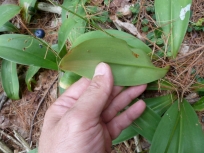
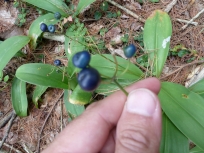
July 29-31, 2011
I went to a Healing with Plants, Fungi and Lichen class with
Arthur Haines of the Delta Institute. The
course was on Friday (7pm-9pm), Saturday (8am-9pm) and Sunday (8am - Noon) with
a lecture, extensive plant walks/harvesting that included very detailed plant
identification and use information.
Pictures from the class can be seen on the following web page:
http://www.transformationalgardening.com/forage/healing-2011-class.html
I was able to get a variety of botany questions answered to help me differentiate
between species in the following genera: Hieracium, Lonicera and
Circaea.
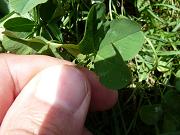
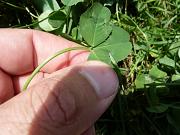
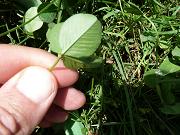
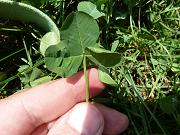

 White clover flowers can vary from white to pink. Alsike Clover (Trifolium
hybridum) flowers can turn pink with age. White Clover leaflets are somewhat
round, while Alsike Clover leaflets are more of an elogated oval shape.
White clover flowers can vary from white to pink. Alsike Clover (Trifolium
hybridum) flowers can turn pink with age. White Clover leaflets are somewhat
round, while Alsike Clover leaflets are more of an elogated oval shape.




 Staghorn Sumac harvesting begins. The fruit is almost ripe and it is only July 17th.
I harvested some of the ripest ones I can find for drying. Once dry, the fruit will
be ground into powder to use as a spice. Have to remember to go back in a few weeks
to harvest the rest for spice and Sumac-aide.
Staghorn Sumac harvesting begins. The fruit is almost ripe and it is only July 17th.
I harvested some of the ripest ones I can find for drying. Once dry, the fruit will
be ground into powder to use as a spice. Have to remember to go back in a few weeks
to harvest the rest for spice and Sumac-aide.
 Matthew Wood has a whole chapter on the healing properties and magical properties
of agrimony in The Book of Herbal Wisdom. I never thought I would find it
within a few miles of my home! I will be getting out there to harvest for tea and
tincture. It was in the damp woods, not far from a creek. There was quite a bit
of Broadleaf Enchanter’s Nightshade (Circaea lutetiana) growing nearby.
Matthew Wood has a whole chapter on the healing properties and magical properties
of agrimony in The Book of Herbal Wisdom. I never thought I would find it
within a few miles of my home! I will be getting out there to harvest for tea and
tincture. It was in the damp woods, not far from a creek. There was quite a bit
of Broadleaf Enchanter’s Nightshade (Circaea lutetiana) growing nearby.
 At first I thought it was a Cinquefoil. Perhaps Tall Cinquefoil (Potentilla
arguta), but Tall Cinquefoil has white flowers. Or Pennsylvania Cinquefoil
(Potentilla pectinata), but the flowers of Pennsylvania Cinquefoil grow in
a cyme rather than on a spike and the leaflets of Pennsylvania Cinquefoil are much
more deeply dissected. Then I thought it might be Pacific Silverweed (Argentina
egedii), but each flower of Pacific Silverweed grows on a separate stalk.
Flipping through all of the yellow flower pictures in a field guide was what saved
the day.
At first I thought it was a Cinquefoil. Perhaps Tall Cinquefoil (Potentilla
arguta), but Tall Cinquefoil has white flowers. Or Pennsylvania Cinquefoil
(Potentilla pectinata), but the flowers of Pennsylvania Cinquefoil grow in
a cyme rather than on a spike and the leaflets of Pennsylvania Cinquefoil are much
more deeply dissected. Then I thought it might be Pacific Silverweed (Argentina
egedii), but each flower of Pacific Silverweed grows on a separate stalk.
Flipping through all of the yellow flower pictures in a field guide was what saved
the day.
 The leaves are alternate and pinnately-divided with 5-9 large, coarsely-toothed
leaflets with tiny leaflets between. The flowers are deep yellow with five petals
and look like cinquefoil flowers except that the flower petals are not notched at
the tip as with some cinquefoils. The flowers grow on spikes and are not densely
packed as they are with Roadside Agrimony (Agrimonia striata).
The leaves are alternate and pinnately-divided with 5-9 large, coarsely-toothed
leaflets with tiny leaflets between. The flowers are deep yellow with five petals
and look like cinquefoil flowers except that the flower petals are not notched at
the tip as with some cinquefoils. The flowers grow on spikes and are not densely
packed as they are with Roadside Agrimony (Agrimonia striata).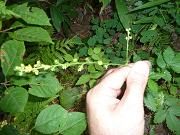
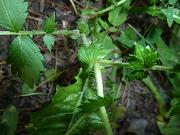
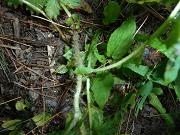

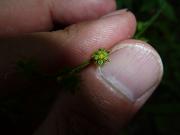
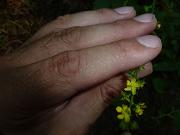
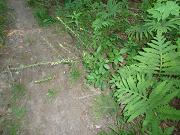
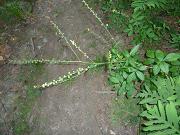
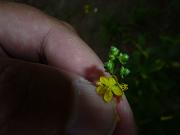
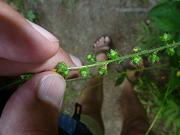

 The flower has two petals that are split to make it look like four petals. Leaves are
opposite and gently, wavy-toothed. Broadleaf Enchanter’s Nightshade differs
from Small Enchanter’s Nightshade (Circaea alpina):
The flower has two petals that are split to make it look like four petals. Leaves are
opposite and gently, wavy-toothed. Broadleaf Enchanter’s Nightshade differs
from Small Enchanter’s Nightshade (Circaea alpina):

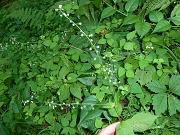
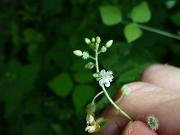
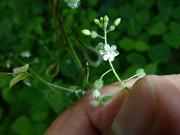
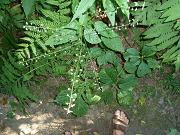
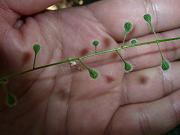
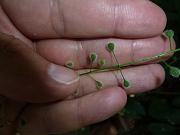
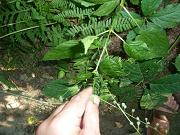
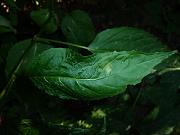
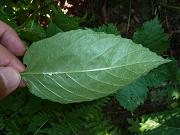

 Showy Ticktrefoil is a large plant -- 2 to 6 feet tall with alternate leaves. Each
leaf has three large leaflets and sheath at the base of the petiole where it attaches
to the stem. The end leaflet has a longer petiole (leaflet stem). The leaflets are
entire (untoothed), 2 to 8 inches long, less than half as wide as long, ovate to
lanceolate and short-pointed at the tip. However, some of the lower leaves have more
oval leaflets as can be seen in one of the pictures below. The stem is very hairy,
feels 4-sided and is streaked vertically with red lines.
Showy Ticktrefoil is a large plant -- 2 to 6 feet tall with alternate leaves. Each
leaf has three large leaflets and sheath at the base of the petiole where it attaches
to the stem. The end leaflet has a longer petiole (leaflet stem). The leaflets are
entire (untoothed), 2 to 8 inches long, less than half as wide as long, ovate to
lanceolate and short-pointed at the tip. However, some of the lower leaves have more
oval leaflets as can be seen in one of the pictures below. The stem is very hairy,
feels 4-sided and is streaked vertically with red lines.
 The flowers are purple, pea flowers that grow on a raceme -- an unbranched inflorescence
bearing flowers with short stalks. Older flowers appear towards the bottom of the
inflorescence and new flowers are produced as the shoot grows. For Showy Ticktrefoil,
the flowers can be bunched closely as seen in the images to the right and below or they
can be spread out slightly more than shown in the pictures.
The flowers are purple, pea flowers that grow on a raceme -- an unbranched inflorescence
bearing flowers with short stalks. Older flowers appear towards the bottom of the
inflorescence and new flowers are produced as the shoot grows. For Showy Ticktrefoil,
the flowers can be bunched closely as seen in the images to the right and below or they
can be spread out slightly more than shown in the pictures.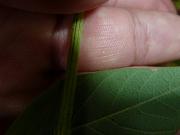
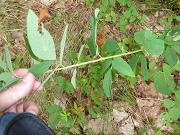
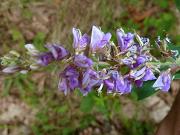
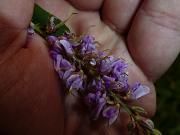
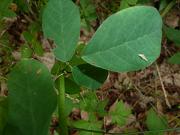

 Painted Trillium is the only Trillium species in New England that has leaf stems.
All of the others have sessile leaves (without leaf stems).
Painted Trillium is the only Trillium species in New England that has leaf stems.
All of the others have sessile leaves (without leaf stems).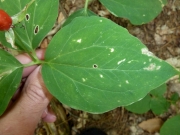
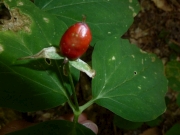
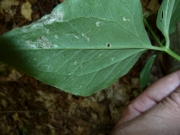
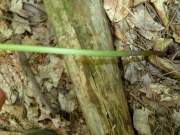

 Not pictured are the yellow flowers that bloom in May and June.
Not pictured are the yellow flowers that bloom in May and June.
